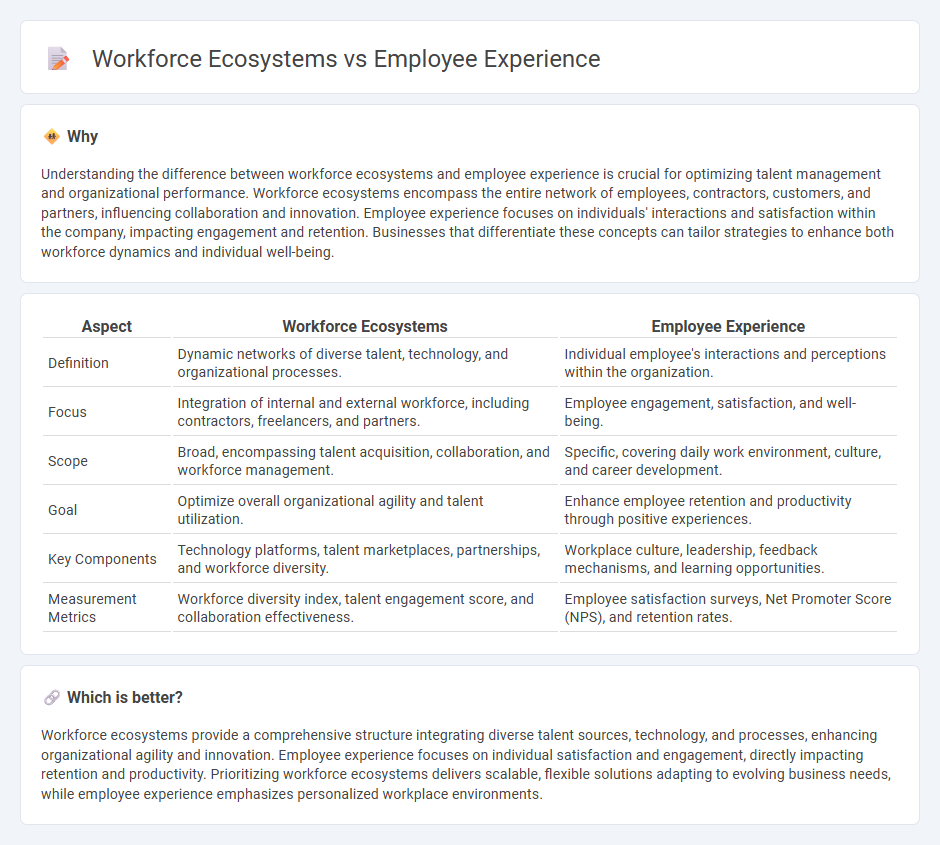
Workforce ecosystems integrate diverse talent sources, technologies, and external partners to create a dynamic and agile organizational structure. Employee experience focuses on optimizing individual interactions and satisfaction within the workplace, encompassing engagement, culture, and personal development. Explore how aligning workforce ecosystems with employee experience drives innovation and competitive advantage.
Why it is important
Understanding the difference between workforce ecosystems and employee experience is crucial for optimizing talent management and organizational performance. Workforce ecosystems encompass the entire network of employees, contractors, customers, and partners, influencing collaboration and innovation. Employee experience focuses on individuals' interactions and satisfaction within the company, impacting engagement and retention. Businesses that differentiate these concepts can tailor strategies to enhance both workforce dynamics and individual well-being.
Comparison Table
| Aspect | Workforce Ecosystems | Employee Experience |
|---|---|---|
| Definition | Dynamic networks of diverse talent, technology, and organizational processes. | Individual employee's interactions and perceptions within the organization. |
| Focus | Integration of internal and external workforce, including contractors, freelancers, and partners. | Employee engagement, satisfaction, and well-being. |
| Scope | Broad, encompassing talent acquisition, collaboration, and workforce management. | Specific, covering daily work environment, culture, and career development. |
| Goal | Optimize overall organizational agility and talent utilization. | Enhance employee retention and productivity through positive experiences. |
| Key Components | Technology platforms, talent marketplaces, partnerships, and workforce diversity. | Workplace culture, leadership, feedback mechanisms, and learning opportunities. |
| Measurement Metrics | Workforce diversity index, talent engagement score, and collaboration effectiveness. | Employee satisfaction surveys, Net Promoter Score (NPS), and retention rates. |
Which is better?
Workforce ecosystems provide a comprehensive structure integrating diverse talent sources, technology, and processes, enhancing organizational agility and innovation. Employee experience focuses on individual satisfaction and engagement, directly impacting retention and productivity. Prioritizing workforce ecosystems delivers scalable, flexible solutions adapting to evolving business needs, while employee experience emphasizes personalized workplace environments.
Connection
Workforce ecosystems integrate diverse talent pools, technologies, and organizational resources, directly shaping the employee experience by fostering collaboration and agility. A well-designed workforce ecosystem enhances employee engagement, productivity, and satisfaction through seamless access to tools and support networks. This connection drives improved retention rates and organizational performance by aligning workforce capabilities with strategic business goals.
Key Terms
Employee Engagement
Employee experience centers on individual interactions, emotions, and satisfaction within the workplace, directly influencing employee engagement and productivity. Workforce ecosystems represent a broader, interconnected network involving employees, technology, partners, and processes that collectively drive organizational performance and innovation. Explore how integrating employee experience into workforce ecosystems can enhance engagement and business outcomes.
Cross-Functional Collaboration
Employee experience enhances engagement by fostering cross-functional collaboration through personalized tools and seamless communication platforms. Workforce ecosystems expand this approach by integrating external partners, technology, and data to create a dynamic, interconnected network that drives innovation and agility. Discover how optimizing these elements can transform organizational performance and employee satisfaction.
Organizational Culture
Employee experience centers on individual perceptions and interactions within the workplace, heavily influenced by organizational culture that shapes engagement and satisfaction. Workforce ecosystems expand this view by integrating technology, external partners, and diverse talent pools, fostering a dynamic culture of collaboration and innovation. Explore how optimizing organizational culture can harmonize employee experience and workforce ecosystems to drive business success.
Source and External Links
What Is the Employee Experience? - Oracle - The employee experience is the culmination of all interactions and touchpoints an employee has with a company, impacting productivity and profitability.
What is Employee Experience? | Definition from TechTarget - Employee experience refers to a worker's perception of their organization during their tenure, encompassing all lifecycle touchpoints.
How to Improve the Employee Experience - Gallup.com - Improving the employee experience involves considering each stage of the employee life cycle to enhance work-life balance and personal wellbeing.
 dowidth.com
dowidth.com